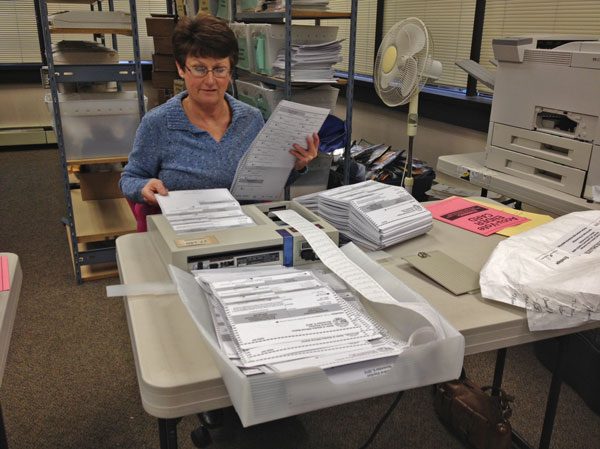
Alaska’s ballot count continued on Wednesday. With a little more than 25,000 additional votes counted, there was only one change in the frontrunner in any race: Sitka Democratic Rep. Jonathan Kreiss-Tomkins went from trailing Republican challenger Kenny Skaflestad by 151 votes to leading by 1,728 votes.
Another race got much tighter. In an East Anchorage House district, Republican Rep. Lance Pruitt’s lead over Democratic candidate Liz Snyder fell from 1,163 to just 56 votes.
RELATED: Trailing legislative Democrats pull ahead in Alaska ballot count; Sullivan, Young keep seats
Ballot Measure 2 currently has more no votes than yes votes, but its chances keep looking better. It now trails by 9,318 votes with at least 66,000 ballots left to count. The measure would overhaul Alaska’s elections system by introducing primaries that are open to all political parties; introducing ranked-choice voting in general elections; and increasing campaign finance transparency.
There were no significant changes in the margins in other statewide races. U.S. President Donald Trump has won Alaska’s three Electoral College votes, according to the Associated Press. The AP also called the U.S. Senate race, in which Republican Sen. Dan Sullivan defeated Al Gross, the Democratic nominee. And in the U.S. House race, Republican Rep. Don Young defeated Alyse Galvin, who like Gross is an independent nominated by the Democrats.
The largest statewide margin is on Ballot Measure 1, where no votes lead yes votes by more than 55,000. The measure would have increased the taxes paid by large oil companies.
Along with the Pruitt-Snyder race, there are three other House races whose outcomes remain in doubt.
In a neighboring South Anchorage district, Republican James Kaufman leads Democratic-nominated independent Suzanne LaFrance by 1,706 votes with roughly 5,800 ballots left to count. In an Anchorage district around Joint Base Elmendorf-Richardson, Republican David Nelson leads Democrat Lyn Franks by 116 votes with roughly 500 ballots left to count. And in a district that includes the North Slope and Northwest Arctic boroughs, independent Josiah Patkotak leads Democrat Elizabeth Ferguson by 397 votes with more than 1,200 votes left to count.
There’s only one race in the state where a Republican incumbent is behind a challenger. That’s in the Anchorage district currently represented by Republican Rep. Mel Gillis, who is trailing Democratic-nominated independent Calvin Schrage.
The outcome of only one Senate race remains uncertain: Republican Roger Holland leads Democrat Carl Johnson by 2,002 votes with roughly 6,500 ballots left to count. They’re competing in a district that includes parts of East and South Anchorage.
In the House, Republicans could win anywhere from 19 to 22 seats, with 21 needed to form a majority. But Kodiak Rep. Louise Stutes has caucused with the mostly Democratic majority for four years. It’s not clear which caucus independent Patkotak would join if he’s elected.
This story was updated at 9:15 p.m. after the second round of results were released from the Division of Elections.
Andrew Kitchenman is the state government and politics reporter for Alaska Public Media and KTOO in Juneau. Reach him at akitchenman@alaskapublic.org.




